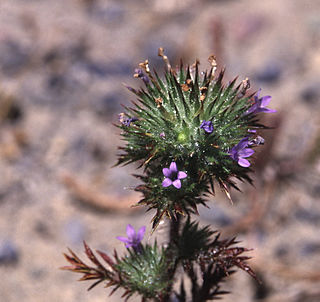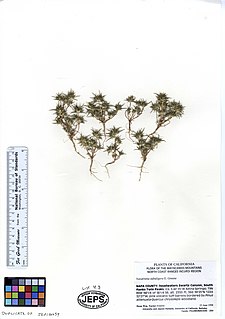
Navarretia is a genus of about 30 species of flowering plants related to the phloxes and the gilias. This is one genus of plants, among others, which are sometimes called pincushionplants. The inflorescence which bears the flowers is surrounded by frilly green bracts bearing soft spines, giving it the appearance of a pincushion. Several species are members of the vernal pool ecosystem.

The Loch Lomond Vernal Pool Ecological Reserve is a nature reserve of 8.22 acres (33,300 m2) in the community of Loch Lomond in Lake County, California. It is one of 119 ecological reserves managed by the California Department of Fish and Game (CDFG). The ecological reserve system was authorized by the state legislature in 1968 for the purpose of conservation and protection of rare plants, animals and habitats.

The Boggs Lake Ecological Reserve is a nature reserve in Lake County, California. The land area is about one quarter of a square mile and contains a large vernal pool as well as endangered plants such as the Boggs Lake hedge-hyssop.

Navarretia atractyloides is a species of flowering plant in the phlox family known by the common name hollyleaf pincushionplant.

Navarretia cotulifolia is a species of flowering plant in the phlox family known by the common name cotulaleaf pincushionplant, or cotula navarretia.

Navarretia fossalis is a rare species of flowering plant in the phlox family known by the common name spreading navarretia.

Navarretia heterandra is an uncommon species of flowering plant in the phlox family known by the common name Tehama pincushionplant, or Tehama navarretia.

Navarretia intertexta is a species of flowering plant in the family phlox, known by the common name needleleaf pincushionplant.
Navarretia jaredii is an uncommon species of flowering plant in the phlox family known by the common names mitrefruit pincushionplant and Paso Robles navarretia.
Navarretia jepsonii is an uncommon species of flowering plant in the phlox family known by the common name Jepson's pincushionplant, or Jepson's navarretia.

Navarretia leucocephala is a species of flowering plant in the phlox family known by the common name whitehead pincushionplant, or whitehead navarretia. It is native to North America, including much of the western United States and central Canada. It generally grows in wet or moist terrestrial habitat such as vernal pools.
Navarretia peninsularis is an uncommon species of flowering plant in the phlox family known by the common names Baja navarretia or Baja pincushionplant. It is native to southern California and Baja California, where it is an occasional member of the flora in wet spots in mountain forests. It is a hairy, glandular annual herb growing up to about 25 centimeters in maximum height. The leaves are 1 to 3 centimeters long and are divided into many very narrow linear or needlelike lobes. The inflorescence is a head of flowers lined with leaflike bracts. The lavender flowers are just under a centimeter long.
Navarretia prostrata is an uncommon species of flowering plant in the phlox family known by the common names prostrate pincushionplant and prostrate vernal pool navarretia. It is endemic to California.
Navarretia rosulata is a rare species of flowering plant in the phlox family known by the common names San Anselmo navarretia, Marin County navarretia, and Marin County pincushionplant.
Navarretia setiloba is a rare species of flowering plant in the phlox family known by the common names Paiute Mountain pincushionplant and Piute Mountains navarretia.

Navarretia subuligera is a species of flowering plant in the phlox family known by the common names awl-leaf pincushionplant or awl-leaved navarretia. It is native to southern Oregon and northern California, where it grows in open, wet habitat, such as meadows and vernal pools. It is a hairy, purple-colored annual herb growing up to about 16 centimeters tall. The leaves are divided into many linear lobes. The inflorescence is a cluster of many flowers surrounded by leaflike bracts with awl-shaped lobes. The flowers are white and under a centimeter in length.
Navarretia tagetina is a species of flowering plant in the phlox family known by the common names marigold pincushionplant and marigold navarretia. It is native to the western United States from Washington to central California, where it grows in wet grassland habitat such as vernal pools. It is a somewhat hairy annual herb growing up to about 30 centimeters tall. The leaves are deeply divided into many spreading needlelike lobes. The inflorescence is a cluster of many flowers surrounded by leaflike bracts. The flowers are pale blue and about a centimeter long.
Navarretia viscidula is a species of flowering plant in the phlox family known by the common name sticky pincushionplant.
Navarretia ojaiensis is a rare species of flowering plant in the phlox family known by the common name Ojai navarretia.

The Phoenix Vernal Pools are located in Fair Oaks, California, a suburb of Sacramento city around 20 miles east of the city of Sacramento and north of highway 50. This land consists of seasonally inundated wetlands that form after winter rains. The climate type of Phoenix Vernal Pools is classified as Mediterranean, receiving 24 in (610 mm) of rain per year. The rainwater percolates into the soil until it reaches an impermeable hardpan that causes an elevated water table, forming the vernal pools. The Phoenix Vernal Pool ecosystem is relatively unique as is supports many species of fauna and flora endemic to vernal pools.
This page is based on this
Wikipedia article Text is available under the
CC BY-SA 4.0 license; additional terms may apply.
Images, videos and audio are available under their respective licenses.











